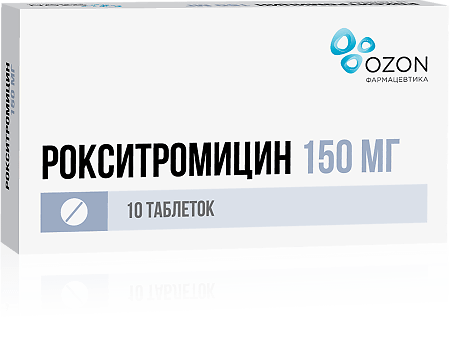No products in the cart.
Roxithromycin, 150 mg 10 pcs
€12.48 €10.40
Description
A semisynthetic antibiotic of the macrolide group. Mechanism of action is caused by disruption of intracellular protein synthesis of microorganisms. At low concentrations it has bacteriostatic action, at high concentrations it has bactericidal action.
Active against Gram-positive bacteria: Streptococcus pneumoniae, Streptococcus pyogenes, methicillin-sensitive strains of Staphylococcus aureus; against Gram-negative bacteria: Moraxella catarrhalis.
Roxytromycin is also active against Mycoplasma pneumoniae, Ureaplasma urealyticum, Chlamidia spp. The activity of roxithromycin against Haemophilus influenzae is expressed to a lesser extent than that of erythromycin.
Low activity against Mycoplasma hominis. Pseudomonas spp., Enterobacter spp., Acinetobacter spp. are resistant to roxithromycin.
Indications
Indications
Infections of mild to moderate severity caused by pathogens sensitive to roxithromycin:
In adults
In children
Active ingredient
Active ingredient
Composition
Composition
Active ingredient:
Roxithromycin – 150.00 mg.
Auxiliary substances (core):
Microcrystalline cellulose – 127.50 mg;
sodium carboxymethyl starch – 9.00 mg;
povidone (polyvinylpyrrolidone) – 9.00 mg;
magnesium stearate – 3.00 mg;
colloidal silicon dioxide – 1.50 mg.
Ancillary substances (coating):
Opadray II White – 10.00 mg, incl.including polyvinyl alcohol – 4.69 mg; macrogol-3350 – 2.36 mg; talc – 1.74 mg; titanium dioxide – 1.21 mg.
How to take, the dosage
How to take, the dosage
Ingestion. The drug should be taken before meals with plenty of fluid. Adults and children over 12 years of age (body weight over 40 kg): the standard dose is 150 mg 2 times a day, 12 hours apart, or 300 mg once (adults only). In elderly patients the single and daily dosage of roxithromycin does not change.
In patients with renal insufficiency In patients with renal insufficiency, roxithromycin is prescribed in a dose of 150 mg 2 times a day.
In patients with severe hepatic failure
In patients with severe hepatic failure (e.g., cirrhosis with jaundice or ascites), the dose should be reduced by half, that is, 150 mg of roxithromycin once daily.
Interaction
Interaction
Concomitant use with indirect anticoagulants may increase the anticoagulant effect.
In concomitant use with ergot preparations, ergotamine-like vasoconstrictors, ergotism up to necrosis of limb tissues may develop.
Concomitant use with digoxin increases the absorption of digoxin.
Concomitant use may slightly increase plasma concentrations of midazolam and triazolam.
Concomitant use with theophylline may increase plasma concentrations of theophylline.
Possible increase in plasma concentrations of cisapride, astemizole, terfenadine in their concomitant use with roxithromycin cannot be excluded.
In concomitant use with cyclosporine there may be some increase in blood concentrations and toxic effects of cyclosporine.
In concomitant use with ethambutol synergism against Mycobacterium avium is noted.
Special Instructions
Special Instructions
With caution is used in patients with hepatic and renal dysfunction.
In case of superinfection or pseudomembranous colitis, roxithromycin should be immediately withdrawn and appropriate therapy should be prescribed.
Cautiously use concomitantly with terfenadine and astemizole.
The experimental studies showed no carcinogenic effects.
Contraindications
Contraindications
– hypersensitivity to roxithromycin, other macrolides or other components of the drug;
– pregnancy;
– lactation;
– porphyria;
– concomitant use of ergot alkaloids (ergotamine and dihydroergotamine);
– concomitant use of cisapride, pimozide, astemizole and terfenadine;
– children under 12 years of age or with body weight less than 40 kg (for this dosage form).
Side effects
Side effects
Liver: increased activity of “liver” transaminases (alanine aminotransferase (ALT) and aspartate aminotransferase (ACT) and/or alkaline phosphatase), acute cholestatic or hepatocellular hepatitis (sometimes with the development of jaundice).
Gastrointestinal tract: nausea, vomiting, abdominal pain, diarrhea (sometimes with blood), pancreatitis, pseudomembranous colitis.
Nervous system disorders: dizziness, headache, paresthesias, changes in taste sensation (including aguesia), olfactory disorders (including
anosmia), hallucinations, temporary hearing loss, hypoacusia (partial hearing loss), vertigo.
Skin reactions: rash, redness, purpura.
Allergic reactions: urticaria, angioedema, bronchospasm, eosinophilia; anaphylactic shock, erythema multiforme.
Other: possible development of superinfection, candidiasis.
Overdose
Overdose
Symptoms: possible intensification of dose-dependent side effects.
Treatment: gastric lavage, symptomatic therapy.
There is no specific antidote.
Additional information
| Manufacturer | Ozon, Russia |
|---|---|
| Medication form | pills |
| Brand | Ozon |
Related products
Buy Roxithromycin, 150 mg 10 pcs with delivery to USA, UK, Europe and over 120 other countries.
















